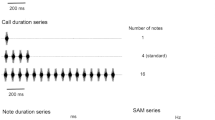Summary
The effect of electrically-elicited middle ear muscle (MEM) contractions on cochlear microphonic potentials (CM) was studied in anesthetized starlings. In addition, the presence or absence of acoustic MEM reflexes was explored in awake starlings and one tawny owl, using the CM for detecting MEM contractions. The most commonly observed effect of electrically-elicited contractions in the anesthetized starlings was a frequency-dependent decrease in CM-amplitude (Fig. 2a) and a shift of the CM input-output functions towards higher SPL's (Fig. 3). It is concluded that the MEM might act as a bandpass filter exerting a (limited) protective effect against acoustic overstimulation of the ear and be capable of extending the ear's dynamic range to higher SPL's. A further physiological significance is discussed. Characteristic CM amplitude modulations, which have previously been shown to result from acoustic reflex contractions of the MEM, were observed in the awake tawny owl, but not in the starlings (Fig. 4).
Similar content being viewed by others
Abbreviations
- CM :
-
cochlear microphonic potentials
- MEM :
-
middle-ear muscle
- SPL :
-
sound pressure level
References
Boord RL (1961) The efferent cochlear bundle in the caiman and pigeon. Exp Neurol 3:225–239
Borg E (1972a) On the change in the acoustic impedance of the ear as a measure of middle ear muscle reflex activity. Acta Otolaryngol 74:163–171
Borg E (1972b) Acoustic middle ear reflexes: A sensory control system. Acta Otolaryngol (Suppl) 304:1–34
Borg E, Zakrisson JE (1975) The activity of the stapedius muscle in man during vocalization. Acta Otolaryngol 79:325–333
Borg E, Counter SA, Rydquist B (1979) Contraction properties and functional morphology of the avian stapedius muscle. Acta Otolaryngol 88:20–26
Counter SA, Borg E (1979) Physiological activation of the stapedius muscle inGallus gallus. Acta Otolaryngol 88:13–19
Desmedt JE, Delwaide PJ (1965) Functional properties of the efferent cochlear bundle of the pigeon revealed by stereotaxic stimulation. Exp Neurol 11:1–26
Dooling RJ, Mulligan JA, Miller JD (1971) Auditory sensitivity and song spectrum of the common canary (Serinus canarius). J Acoust Soc Am 50:700–709
Evans HE (1975) Nomina anatomica avium. Organa sensum, final list of terms. Int Comm Avian Anat Nomenclature (ICAAN)
Fex J (1963) Crossed cochlear efferents activated by sound through both ears. Acta Physiol Scand 59 (Suppl. 213):41
Fex J (1965) Auditory activity in uncrossed centrifugal cochlear fibers in cat. Acta Physiol Scand 64:43–57
Golubeva TB (1972) The reflex activity of the tympanal muscle in the owlAsia otus. Zh Evol Biol Fiziol 8:173–181
Iljitschew VD (1974) Adaptionsökologische Parallelismen — mosaikartige Evolution. Das Hörsystem der Vögel als Objekt der funktionellen Morphologie. Biol Zentralbl 93:165–180
Konishi M (1970) Comparative neurophysiological studies of hearing and vocalizations in songbirds. Z Vergl Physiol 66:257–272
Lidén G, Nordlund B, Hawkins JE (1964) Significance of the stapedius reflex for the understanding of speech. Acta Otolaryngol (Suppl) 188:275–279
Møller AR (1974a) Function of the middle ear. In: Keidel WD, Neff WD (eds) Handbook of sensory physiology, vol V/1. Springer, Berlin Heidelberg New York, pp 491–517
Møller AR (1974b) The acoustic middle ear muscle reflex. In: Keidel WD, Neff WD (eds) Handbook of sensory physiology, vol V/1. Springer, Berlin Heidelberg New York, pp 519–548
Oeckinghaus H (1978) Einenfluß von Kontraktionen des Mittel-ohrmuskels auf die Entladung von Hörnervenelementen beim Star. Verh Dtsch Zool Ges 1978:191
Oeckinghaus H, Schwartzkopff J (1975) Elektrische Aktivierung des Mittelohrmuskels beim Star. Naturwissenschaften 62:582
Pohlman AG (1921) The position and functional interpretation of the elastic ligaments in the middle-ear region ofGallus. J Morphol 35:229–262
Schwartzkopff J, Brémond JC (1963) Méthode de dérivation des potentiels cochléaires chez l'oiseau. J Physiol (Paris) 55:495–518
Schwartzkopff J, Winter P (1960) Zur Anatomie der Vogel-Cochlea unter natürlichen Bedingungen. Biol Zentralbl 79:607–625
Stresemann E (1934) Sauropsida, Aves. In: Kükenthal W, Krumbach T (eds) Handbuch der Zoologie, vol III/2, de Gruyter, Berlin
Suga N, Jen PH-S (1975) Peripheral control of acoustic signals in the auditory system of echolocating bats. J Exp Biol 62:277–311
Teig E (1973) Differential effect of graded contraction of middle ear muscles on the sound transmission of the ear. Actä Physiol Scand 88:382–391
Trainer JE (1946) The auditory acuity of certain birds. Ph D thesis, Cornell University, Ithaca (New York)
Wada Y (1924) Beiträge zur vergleichenden Physiologie des Gehörorgans. Pflügers Arch 202:46–49
Author information
Authors and Affiliations
Rights and permissions
About this article
Cite this article
Oeckinghaus, H., Schwartzkopff, J. Electrical and acoustical activation of the middle ear muscle in a songbird. J. Comp. Physiol. 150, 61–67 (1983). https://doi.org/10.1007/BF00605288
Accepted:
Issue Date:
DOI: https://doi.org/10.1007/BF00605288




